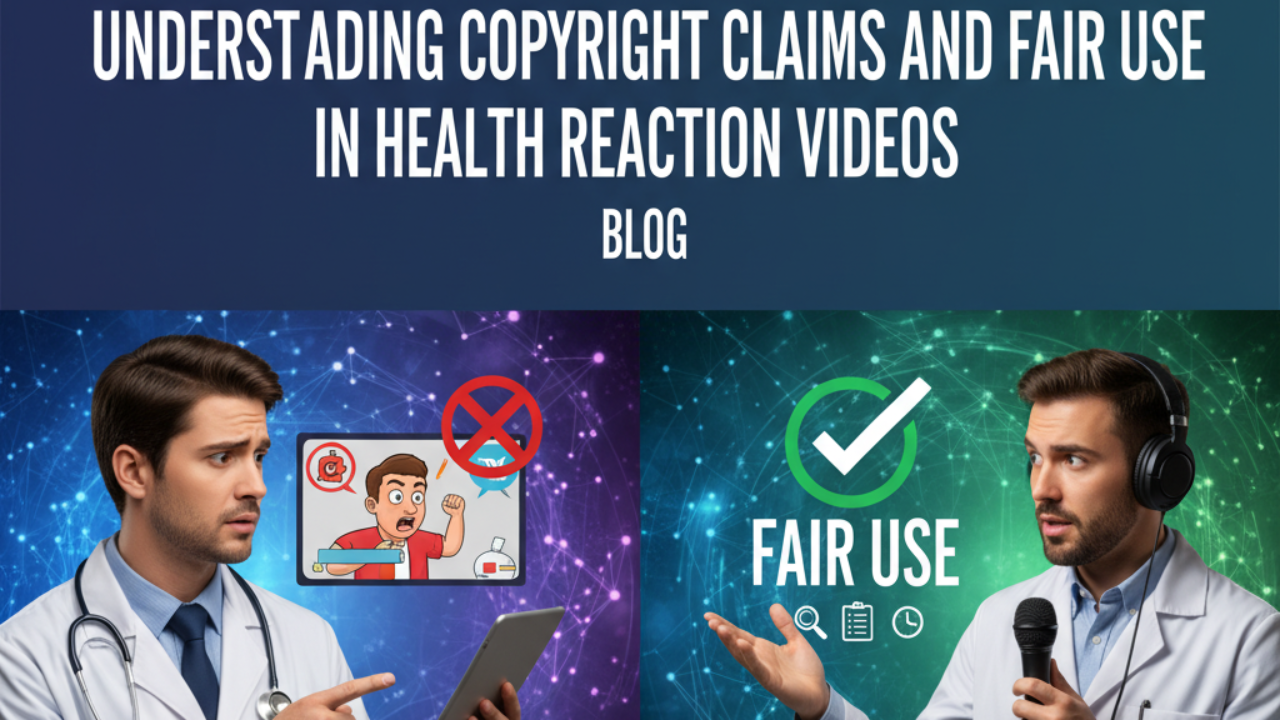Copyright Claims, Fair Use, and Staying Safe

I Recently met Dr Sermed Mezher at a small health creator gathering in London and I want to raise awareness of his excellent YT channel and to use at as a case study to explore the category of reaction videos. https://www.youtube.com/@DrSermedMezher
I am sure you have seen them in your social media feeds, they usually feature the talking head of the presenter overlayed onto the video that they are commenting on.
The technical process of creating a reaction video is something I will cover in another blog or video.
This video explains how so many people are getting away with publishing other people’s content while commenting and reacting to it.
So lets jump straight into:
Copyright Claims, Fair Use, and Staying Safe on YouTube as a Health Creator
Creating health videos for YouTube is incredibly rewarding
but it can also bring a few problems if you’re not careful with copyrighted material. Whether you’re reacting to another creator’s video, breaking down a medical news story, or adding clips to support your message, understanding copyright claims, fair use, and YouTube’s three-strike policy is essential.
YouTube Copyright Claims vs. Copyright Strikes
A copyright claim is not the same as a strike.
A copyright claim is usually automated — triggered by YouTube’s Content ID system, which scans uploaded videos against a database of copyrighted material. If it detects a match, the owner of that content can:
- Monetize your video and collect the ad revenue,
- Block your video, or
- Track your video’s performance.
A claim doesn’t harm your channel’s standing, and you can appeal it if you believe your use qualifies as fair use.
I will cover fair use in just a moment.
A copyright strike, on the other hand, is much more serious. It’s a manual takedown request for alleged infringement, and it removes your video completely. If you receive three strikes within 90 days, YouTube can terminate your channel. Although I believe this is incredibly rare.
Music Is More of a Problem Than Video
While short video clips used for commentary often fall under fair use, music rarely does. Even a few seconds of a copyrighted song can trigger a claim or strike because music rights are strictly enforced.
If you want to stay safe:
- Use royalty-free or licensed tracks (from platforms like Epidemic Sound, Artlist, or YouTube Audio Library).
- Avoid background music from other creators, even if it’s subtle.
What Is Fair Use?
Under Title 17 §107 of U.S. Copyright Law, “fair use” allows you to use copyrighted material without permission for specific purposes — including criticism, comment, teaching, scholarship, or research.
Here’s the exact wording from 17 U.S.C. §107:
“Notwithstanding the provisions of sections 106 and 106A, the fair use of a copyrighted work... for purposes such as criticism, comment, news reporting, teaching (including multiple copies for classroom use), scholarship, or research, is not an infringement of copyright.”
In short, if your use transforms the original work — adding new meaning, commentary, or educational value — it can be fair use.
The Key Idea: Transformative Use
The central question is whether your video transforms the original material.
Examples that often count as fair use include:
- Adding analysis, education, or criticism
- Reacting and pausing to discuss what’s happening
- Editing or recontextualizing footage to make a new creative statement
Not fair use:
- Uploading long clips with little or no commentary
- Playing most of a video uninterrupted
- Using someone else’s content as filler instead of creating your own
- Editing content to misrepresent the original content. (BBC/Trump example)
There’s no exact rule for how much you can use, but 2–5 seconds is often a safe guideline — as long as it’s necessary for your commentary.
The Four Factors of Fair Use
Courts and YouTube consider these four factors together:
- Purpose and character of the use
Educational or transformative uses are favored over purely commercial ones. - Nature of the copyrighted work
Factual content (like a news clip) is safer than creative works (like a movie or song). - Amount and substantiality used
Use only what’s needed to make your point — avoid lengthy sections. - Effect on the market
If your video could replace the original or reduce its market value, it’s less likely to be fair use.
YouTube’s Reality Check
Even if your content clearly qualifies as fair use, YouTube’s Content ID system isn’t the law. It’s automated — and may flag your video anyway.
If you get a claim, you can:
- Accept it (and possibly lose ad revenue),
- Mute, trim, or replace the claimed section, or
- Dispute it if you believe it falls under fair use.
Ultimately, only a court can make the final determination — but YouTube provides a process to challenge unfair claims.
Practical Tips for Reaction and Commentary Videos
- Pause often to add your own analysis, insight, or humor.
- Keep clips short and directly relevant to your discussion.
- Add value — teach, interpret, or critique, rather than just restating.
- Don’t rely on music unless it’s licensed or royalty-free.
- Credit original sources — not required, but good practice.
- Be ready to dispute claims you believe are fair use.
Final Thoughts
For health content creators, using snippets of other videos or articles can help you teach, react, or inspire discussion — all of which can qualify as fair use when done correctly. The key is to transform the content, add educational value, and respect copyright boundaries.
So you can stay creative and keep producing videos that help educate and empower your audience without risking your channel.
